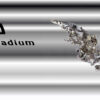An international team of researchers has uncovered evidence that astrophysics models of massive stars and supernovae are inconsistent with observational gamma-ray astronomy.
The team investigated iron-60, an unstable isotope, using a new experimental method. Iron-60 interests astrophysicists because it originates inside massive stars and is ejected from supernovae across the galaxy. Their findings appear in Nature Communications.
Team members included Artemis Spyrou, professor of physics at the Facility for Rare Isotope Beams (FRIB) and in the Michigan State University (MSU) Department of Physics and Astronomy; Sean Liddick, associate professor of chemistry at FRIB and in MSU’s Department of Chemistry and Experimental Nuclear Science Department head at FRIB, and 11 FRIB graduate students and postdoctoral researchers.
To investigate the isotope, Spyrou’s team conducted an experiment at the National Superconducting Cyclotron Laboratory (FRIB’s predecessor) using a novel method developed jointly with Ann-Cecilie Larsen, professor of nuclear and energy physics, and Magne Guttormsen, professor emeritus, both at the University of Oslo in Norway.
“The unique thing that we brought into this collaboration was that we combined our expertise in nuclear reactions, isotope beams, and beta decay to learn about a reaction that we can’t measure directly,” Spyrou said. “For this paper, we sought to measure enough of the properties surrounding the reaction we were interested in so that we could constrain it better than before.”
Models are essential for predicting rare astrophysical events
Iron-60 has a long half-life for an unstable isotope—more than 2 million years—so it leaves a lasting signature of the supernova from which it originated. Specifically, iron-60 emits gamma rays as it decays that scientists can measure and analyze for clues about the life cycle of stars and the mechanisms of their explosive deaths. Physicists rely on this data to create and improve astrophysical models.
“One of the overarching goals of nuclear science is to achieve a comprehensive, predictive model of a nucleus that will accurately describe the nuclear properties of any atomic system,” said Liddick, “but we just don’t have that yet. We have to experimentally measure these processes first.”
Scientists need to produce these rare isotopes, observe them, and then compare their findings with the model’s prediction to check for accuracy.
“To study these nuclei, we can’t just find them naturally on Earth,” said Spyrou. “We have to make them. And that is the specialty of FRIB—to get stable isotopes that we can find, accelerate them, fragment them, and then produce these exotic isotopes, which might only live for a few milliseconds, so we can study them.”
To that end, Spyrou and her team devised an experiment that served two purposes: First, they aimed to constrain the neutron-capture process that transforms the isotope iron-59 into iron-60; second, they wanted to use the resulting data to investigate long-standing discrepancies between supernova model predictions and the observed traces of these isotopes.
New method enables better study of short-lived isotopes
While iron-60 has a relatively long half-life, its neighbor iron-59 is less stable and will decay with a half-life of 44 days. This makes the neutron capture on iron-59 especially challenging to measure in the laboratory, since it decays away before reasonable measurements can be performed. To overcome this problem, the scientists developed their own indirect methods of constraining this reaction experimentally.
Spyrou and Liddick worked closely with their colleagues at the University of Oslo to develop a new method for studying these highly unstable isotopes. The result, called the beta-Oslo Method, is a variation of the Oslo Method first developed by project co-author Guttormsen at the Oslo Cyclotron Laboratory.
Guttormsen’s approach uses a nuclear reaction to populate a nucleus so that researchers can measure its properties. Though it has proven over several decades to have many astrophysics and nuclear structure applications, it was only possible to apply it to (near-) stable isotopes.
By combining their expertise in detection, beta decay, and reactions, the researchers devised a way to populate a target nucleus using the process of beta decay itself rather than a reaction. This innovative approach produced the isotope they were looking for much more efficiently and provided a path to constraining neutron-capture reactions on short-lived nuclei.
“The beta-Oslo method is still the only technique that can give us some of these constraints on very exotic nuclei that are far from stability,” said Spyrou.
Correcting the models will take time
After constraining these key uncertainties about the nuclear reaction network that produces iron-60, Spyrou’s team concluded that the likelihood of that reaction happening inside a massive star is higher than model predictions by as much as a factor of two. The researchers now believe that theoretical models of supernovae are flawed, and that there are specific stellar properties that are still incorrectly represented.
In their paper’s conclusion, the researchers stated, “The solution to the puzzle must come from the stellar modeling by, for example, reducing stellar rotation, assuming smaller explodability mass limits for massive stars, or modifying other stellar parameters.”
This discovery not only has far-reaching implications for the theoretical understanding of massive stars and the conditions inside them, but it also further demonstrated that the beta-Oslo Method will be a valuable tool for scientists moving forward.
“This wouldn’t have worked without our project partners at the University of Oslo, who inspired Artemis and me when they presented the Oslo method at a 2014 seminar at MSU,” said Liddick.
“We approached them that day with our question about using beta decay, and discussions took off from there. We’ve worked together ever since, and I have no doubt we will continue to collaborate long into the future.”
More information:
A. Spyrou et al, Enhanced production of 60Fe in massive stars, Nature Communications (2024). DOI: 10.1038/s41467-024-54040-4
Provided by
Michigan State University Facility for Rare Isotope Beams
Citation:
Scientists identify flaw in astrophysics models of massive stars and supernovae (2024, November 13)



